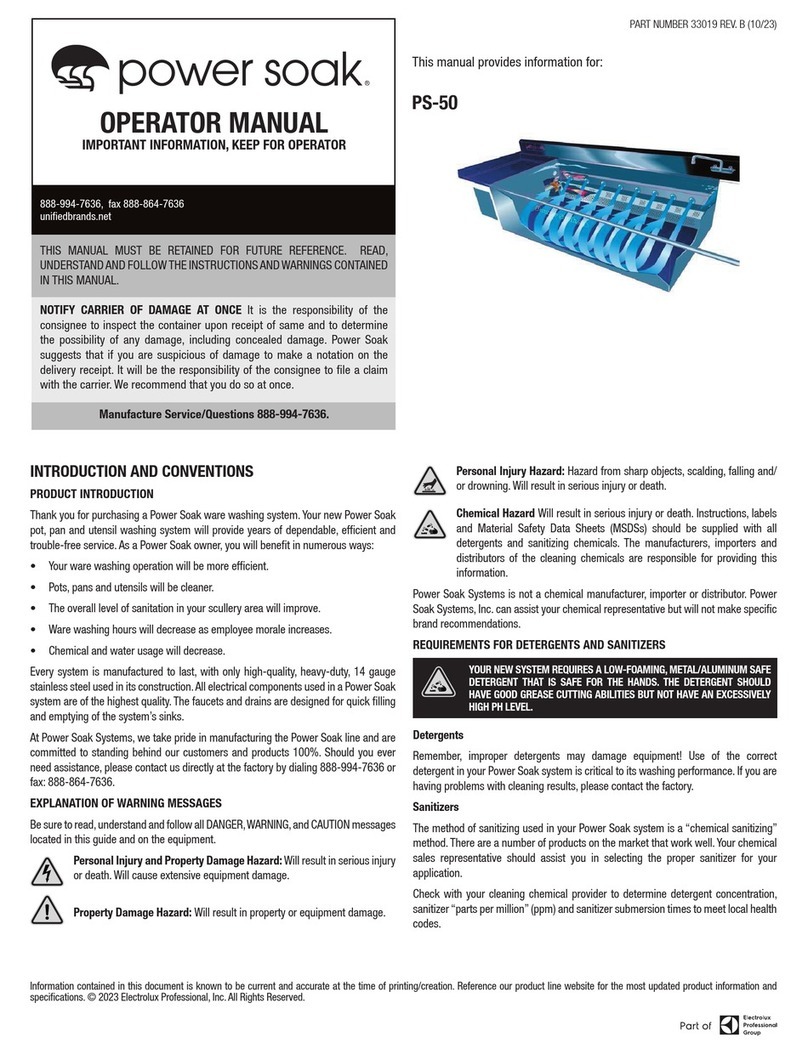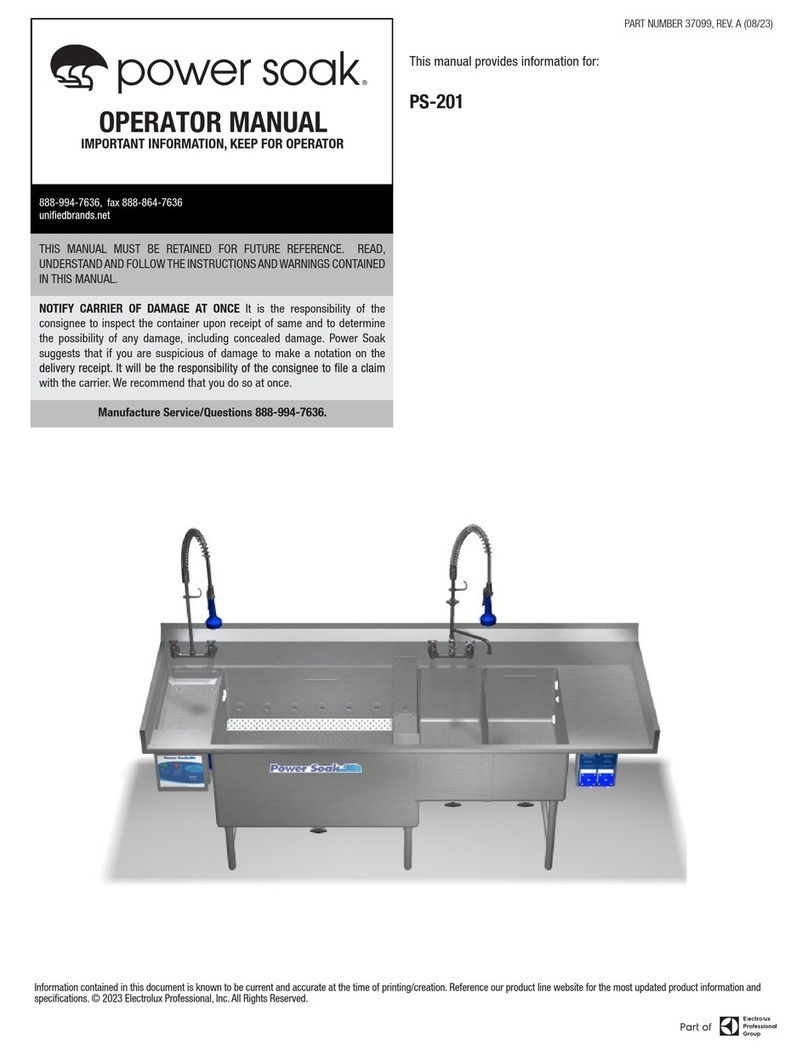
8 OM-POWER SOAK OM-POWER SOAK 9
Operation
CONTROLS
Starting and Stopping the Wash Action
To start the wash action, turn the red and black handle clockwise to the “ON” position. A
strong “rolling” action of the water in the wash sink should begin.
To stop the wash action, turn the red and black handle counter-clockwise to the “OFF”
position.
Introducing Pots and Pans to the Power Soak
Dirty pots and pans should be brought to the Power Soak in a timely manner. Do not allow
items to sit and air dry. The quicker that items are brought to the Power Soak and put in
the wash tank, the easier they are to clean.
Properly Scrapping Pots and Pans
Excess soils should be removed from the pots and pans prior to dropping them in the
wash sink.
Deposit the excess soils into a garbage can.
Some systems may have an optional pre-scrapping area with a pre-rinse spray. If so, soils
may be deposited into the scrapper sink.
Loading and Using the Wash Sink
The Power Soak is a “random loading” system. This means that Power Soak items are not
racked for washing. Instead, they are randomly loaded one at a time.
An exception are sheet pans which may be held in racks specially designed for this
purpose. These racks are an optional accessory for your Power Soak Basic.
As items are brought to the system and scrapped, they should be immediately dropped
into the wash sink.
If there is no movement of items in the wash sink, or if items are stationary above the
waterline, the system has been overloaded and some items must be removed.
It is very important not to overload the wash sink, as it reduces the effectiveness of the
wash action.
Some pots and pans stack for storage. This is referred to as “nesting” when it occurs
during Power Soak operation. Make sure that nested items are separated and loaded one
at a time. Nested items in the wash sink will not be properly washed.
Power Soak is a “continuous motion” system. This means that the system does not
operate on a set cycle time like cabinet-type washing systems. Instead, during normal
operating hours where washing is required, the system is (normally) left running. The
Power Soak is energy efcient, and it does not cause excessive wear to leave it running
continuously.
Typically, it takes between three to fteen minutes to wash most items. Some heavily
soiled wares or items with burnt-on soils may take longer to clean.
WARNING
RUNNING THE MACHINE WITHOUT WATER IN
THE WASH SINK WILL CAUSE DAMAGE THAT
IS NOT COVERED BY THE WARRANTY.
WARNING
WARES TUMBLING IN THE POWER SOAK
WASH SINK MAY SPLASH FLUID FROM THE
SINK CREATING A WET FLOOR IN FRONT OF
THE POWER SOAK WASH SINK. BE AWARE
THAT A WET FLOOR MAY CAUSE A PERSON
TO SLIP AND FALL LEADING TO A SERIOUS
INJURY OR DEATH.
Operation
Loading and Washing Utensils
An optional accessory for your Power Soak Basic system is a utensil basket that hangs
in the wash sink. All utensils and other small wares should be loaded into and washed
inside this basket.
Unloading the Wash Sink
The employee responsible for pot washing should routinely pass by the Power Soak and
remove clean items from the wash sink.
Items that are not 100% clean can be quickly nished off with a scrub pad or dropped
back into the wash sink for additional cleaning.
Remember: it is not necessary to turn the wash action off to load or unload items from the
wash sink. There are no moving parts within the wash sink that could cause bodily harm.
Rinsing Pots and Pans
Clean items that have been removed from the wash sink should be thoroughly rinsed.
This is achieved by spraying them off or dipping them in the rinse sink (center sink).
It is important that any remaining detergent residue be removed from the items prior to
sanitizing them.
If items are rinsed by the “dipping” method, it is important to keep the water “fresh” by
frequently draining and lling the rinse sink.
Sanitizing Pots and Pans
After items have been properly rinsed they must be sanitized in the sanitizing sink. This is
the sink farthest from the wash sink.
It is necessary for each item to remain immersed in the sanitizing solution for a specic
amount of time. The time varies according to the type of sanitizer being used and local
health codes.
Be sure to follow your chemical sales representative’s instructions to ensure that all items
are properly sanitized.
Drying of Pots and Pans
After items have been sanitized, they should be thoroughly dried on a clean drain board or
on adjacent drying shelves.
Be sure to adhere to all local health codes and recommendations for proper drying and
stacking of items.
Wash, Rinse and Sanitizer Clean-Up
Between each water change and at the end of each night, all sinks and drain boards
should be thoroughly cleaned with hot, soapy water.
It is also recommended to wipe down all the sinks and drain boards with a sanitizing
agent. Ask your chemical provider to recommend a sanitizer for this application.
WARNING
DO NOT PLACE KNIVES OR OTHER SHARP
OBJECTS IN THE POWER SOAK. ALLOWING
KNIVES OR OTHER SHARP OBJECTS TO
TUMBLE FREELY IN THE POWER SOAK SINK
MAY CAUSE BODILY INJURY.
KNIVES AND OTHER SHARP OBJECTS
MUST BE WASHED BY HAND WITH THE
PUMP MOTOR TURNED OFF. WASH, RINSE
AND SANITIZE THE KNIFE OR SHARP
OBJECT, WITHOUT LETTING GO OF THE
ITEM. IMMEDIATELY PLACE THE ITEM INTO
PROPER STORAGE.
A FULLY LOADED UTENSIL BASKET CAN BE
VERY HEAVY. UNLOAD THE BASKET PRIOR
TO LIFTING THE BASKET OUT OF THE SINK.
DO NOT ATTEMPT TO LIFT A FULLY LOADED
UTENSIL BASKET. ATTEMPTING TO LIFT A
FULLY LOADED UTENSIL BASKET CAN CAUSE
A MUSCLE STRAIN.
BE SURE TO ADJUST KNOBS ON THE SPRAY
RINSE AND ALL WATER FAUCETS SO THAT
THE WATER TEMPERATURE IS BELOW 120°F
(49°C). HIGHER TEMPERATURES CAN CAUSE
SCALDING.
DO NOT ATTEMPT TO OCCUPY ANY OF THE
SINKS ON THE POWER SOAK MACHINE. BE
CAUTIOUS NOT TO FALL INTO ANY OF THE
SINKS ON THE POWER SOAK MACHINE.
THE FLUID DEPTH IS SUFFICIENT FOR A
PERSON’S HEAD TO BE SUBMERGED AND
CAUSE A DROWNING DEATH.


























